Input interpretation

Na_2SO_4 sodium sulfate + Mg(NO_3)_2 magnesium nitrate ⟶ NaNO_3 sodium nitrate + MgSO_4 magnesium sulfate
Balanced equation
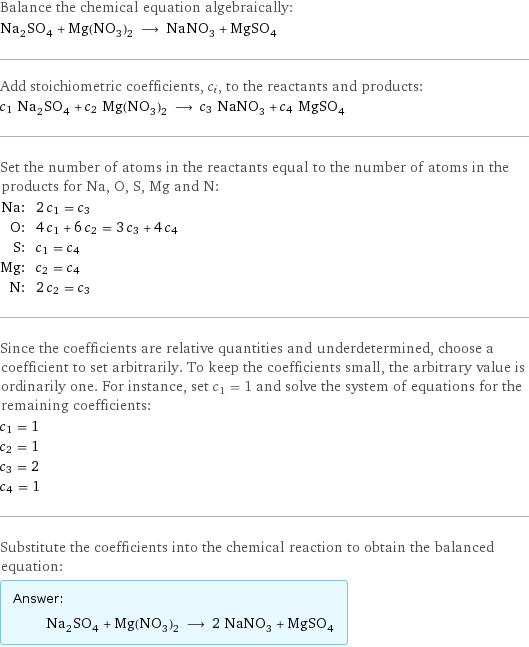
Balance the chemical equation algebraically: Na_2SO_4 + Mg(NO_3)_2 ⟶ NaNO_3 + MgSO_4 Add stoichiometric coefficients, c_i, to the reactants and products: c_1 Na_2SO_4 + c_2 Mg(NO_3)_2 ⟶ c_3 NaNO_3 + c_4 MgSO_4 Set the number of atoms in the reactants equal to the number of atoms in the products for Na, O, S, Mg and N: Na: | 2 c_1 = c_3 O: | 4 c_1 + 6 c_2 = 3 c_3 + 4 c_4 S: | c_1 = c_4 Mg: | c_2 = c_4 N: | 2 c_2 = c_3 Since the coefficients are relative quantities and underdetermined, choose a coefficient to set arbitrarily. To keep the coefficients small, the arbitrary value is ordinarily one. For instance, set c_1 = 1 and solve the system of equations for the remaining coefficients: c_1 = 1 c_2 = 1 c_3 = 2 c_4 = 1 Substitute the coefficients into the chemical reaction to obtain the balanced equation: Answer: | | Na_2SO_4 + Mg(NO_3)_2 ⟶ 2 NaNO_3 + MgSO_4
Structures

+ ⟶ +
Names

sodium sulfate + magnesium nitrate ⟶ sodium nitrate + magnesium sulfate
Reaction thermodynamics
Enthalpy
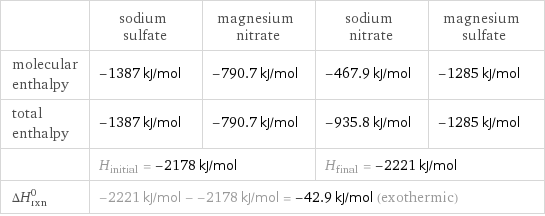
| sodium sulfate | magnesium nitrate | sodium nitrate | magnesium sulfate molecular enthalpy | -1387 kJ/mol | -790.7 kJ/mol | -467.9 kJ/mol | -1285 kJ/mol total enthalpy | -1387 kJ/mol | -790.7 kJ/mol | -935.8 kJ/mol | -1285 kJ/mol | H_initial = -2178 kJ/mol | | H_final = -2221 kJ/mol | ΔH_rxn^0 | -2221 kJ/mol - -2178 kJ/mol = -42.9 kJ/mol (exothermic) | | |
Gibbs free energy
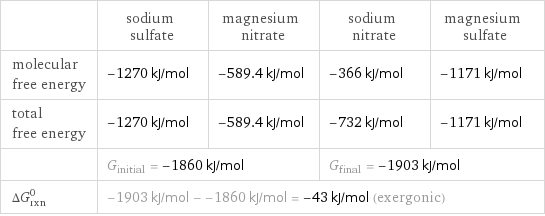
| sodium sulfate | magnesium nitrate | sodium nitrate | magnesium sulfate molecular free energy | -1270 kJ/mol | -589.4 kJ/mol | -366 kJ/mol | -1171 kJ/mol total free energy | -1270 kJ/mol | -589.4 kJ/mol | -732 kJ/mol | -1171 kJ/mol | G_initial = -1860 kJ/mol | | G_final = -1903 kJ/mol | ΔG_rxn^0 | -1903 kJ/mol - -1860 kJ/mol = -43 kJ/mol (exergonic) | | |
Equilibrium constant
![Construct the equilibrium constant, K, expression for: Na_2SO_4 + Mg(NO_3)_2 ⟶ NaNO_3 + MgSO_4 Plan: • Balance the chemical equation. • Determine the stoichiometric numbers. • Assemble the activity expression for each chemical species. • Use the activity expressions to build the equilibrium constant expression. Write the balanced chemical equation: Na_2SO_4 + Mg(NO_3)_2 ⟶ 2 NaNO_3 + MgSO_4 Assign stoichiometric numbers, ν_i, using the stoichiometric coefficients, c_i, from the balanced chemical equation in the following manner: ν_i = -c_i for reactants and ν_i = c_i for products: chemical species | c_i | ν_i Na_2SO_4 | 1 | -1 Mg(NO_3)_2 | 1 | -1 NaNO_3 | 2 | 2 MgSO_4 | 1 | 1 Assemble the activity expressions accounting for the state of matter and ν_i: chemical species | c_i | ν_i | activity expression Na_2SO_4 | 1 | -1 | ([Na2SO4])^(-1) Mg(NO_3)_2 | 1 | -1 | ([Mg(NO3)2])^(-1) NaNO_3 | 2 | 2 | ([NaNO3])^2 MgSO_4 | 1 | 1 | [MgSO4] The equilibrium constant symbol in the concentration basis is: K_c Mulitply the activity expressions to arrive at the K_c expression: Answer: | | K_c = ([Na2SO4])^(-1) ([Mg(NO3)2])^(-1) ([NaNO3])^2 [MgSO4] = (([NaNO3])^2 [MgSO4])/([Na2SO4] [Mg(NO3)2])](../image_source/9fbe150f15057bf5b8873c17f4715650.png)
Construct the equilibrium constant, K, expression for: Na_2SO_4 + Mg(NO_3)_2 ⟶ NaNO_3 + MgSO_4 Plan: • Balance the chemical equation. • Determine the stoichiometric numbers. • Assemble the activity expression for each chemical species. • Use the activity expressions to build the equilibrium constant expression. Write the balanced chemical equation: Na_2SO_4 + Mg(NO_3)_2 ⟶ 2 NaNO_3 + MgSO_4 Assign stoichiometric numbers, ν_i, using the stoichiometric coefficients, c_i, from the balanced chemical equation in the following manner: ν_i = -c_i for reactants and ν_i = c_i for products: chemical species | c_i | ν_i Na_2SO_4 | 1 | -1 Mg(NO_3)_2 | 1 | -1 NaNO_3 | 2 | 2 MgSO_4 | 1 | 1 Assemble the activity expressions accounting for the state of matter and ν_i: chemical species | c_i | ν_i | activity expression Na_2SO_4 | 1 | -1 | ([Na2SO4])^(-1) Mg(NO_3)_2 | 1 | -1 | ([Mg(NO3)2])^(-1) NaNO_3 | 2 | 2 | ([NaNO3])^2 MgSO_4 | 1 | 1 | [MgSO4] The equilibrium constant symbol in the concentration basis is: K_c Mulitply the activity expressions to arrive at the K_c expression: Answer: | | K_c = ([Na2SO4])^(-1) ([Mg(NO3)2])^(-1) ([NaNO3])^2 [MgSO4] = (([NaNO3])^2 [MgSO4])/([Na2SO4] [Mg(NO3)2])
Rate of reaction
![Construct the rate of reaction expression for: Na_2SO_4 + Mg(NO_3)_2 ⟶ NaNO_3 + MgSO_4 Plan: • Balance the chemical equation. • Determine the stoichiometric numbers. • Assemble the rate term for each chemical species. • Write the rate of reaction expression. Write the balanced chemical equation: Na_2SO_4 + Mg(NO_3)_2 ⟶ 2 NaNO_3 + MgSO_4 Assign stoichiometric numbers, ν_i, using the stoichiometric coefficients, c_i, from the balanced chemical equation in the following manner: ν_i = -c_i for reactants and ν_i = c_i for products: chemical species | c_i | ν_i Na_2SO_4 | 1 | -1 Mg(NO_3)_2 | 1 | -1 NaNO_3 | 2 | 2 MgSO_4 | 1 | 1 The rate term for each chemical species, B_i, is 1/ν_i(Δ[B_i])/(Δt) where [B_i] is the amount concentration and t is time: chemical species | c_i | ν_i | rate term Na_2SO_4 | 1 | -1 | -(Δ[Na2SO4])/(Δt) Mg(NO_3)_2 | 1 | -1 | -(Δ[Mg(NO3)2])/(Δt) NaNO_3 | 2 | 2 | 1/2 (Δ[NaNO3])/(Δt) MgSO_4 | 1 | 1 | (Δ[MgSO4])/(Δt) (for infinitesimal rate of change, replace Δ with d) Set the rate terms equal to each other to arrive at the rate expression: Answer: | | rate = -(Δ[Na2SO4])/(Δt) = -(Δ[Mg(NO3)2])/(Δt) = 1/2 (Δ[NaNO3])/(Δt) = (Δ[MgSO4])/(Δt) (assuming constant volume and no accumulation of intermediates or side products)](../image_source/bc8688071fea6793e382a3ec4a52dfea.png)
Construct the rate of reaction expression for: Na_2SO_4 + Mg(NO_3)_2 ⟶ NaNO_3 + MgSO_4 Plan: • Balance the chemical equation. • Determine the stoichiometric numbers. • Assemble the rate term for each chemical species. • Write the rate of reaction expression. Write the balanced chemical equation: Na_2SO_4 + Mg(NO_3)_2 ⟶ 2 NaNO_3 + MgSO_4 Assign stoichiometric numbers, ν_i, using the stoichiometric coefficients, c_i, from the balanced chemical equation in the following manner: ν_i = -c_i for reactants and ν_i = c_i for products: chemical species | c_i | ν_i Na_2SO_4 | 1 | -1 Mg(NO_3)_2 | 1 | -1 NaNO_3 | 2 | 2 MgSO_4 | 1 | 1 The rate term for each chemical species, B_i, is 1/ν_i(Δ[B_i])/(Δt) where [B_i] is the amount concentration and t is time: chemical species | c_i | ν_i | rate term Na_2SO_4 | 1 | -1 | -(Δ[Na2SO4])/(Δt) Mg(NO_3)_2 | 1 | -1 | -(Δ[Mg(NO3)2])/(Δt) NaNO_3 | 2 | 2 | 1/2 (Δ[NaNO3])/(Δt) MgSO_4 | 1 | 1 | (Δ[MgSO4])/(Δt) (for infinitesimal rate of change, replace Δ with d) Set the rate terms equal to each other to arrive at the rate expression: Answer: | | rate = -(Δ[Na2SO4])/(Δt) = -(Δ[Mg(NO3)2])/(Δt) = 1/2 (Δ[NaNO3])/(Δt) = (Δ[MgSO4])/(Δt) (assuming constant volume and no accumulation of intermediates or side products)
Chemical names and formulas
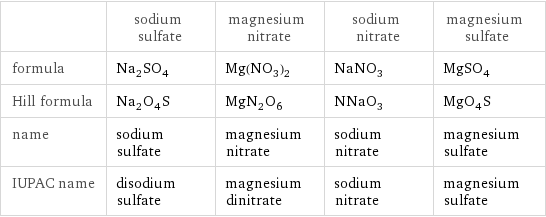
| sodium sulfate | magnesium nitrate | sodium nitrate | magnesium sulfate formula | Na_2SO_4 | Mg(NO_3)_2 | NaNO_3 | MgSO_4 Hill formula | Na_2O_4S | MgN_2O_6 | NNaO_3 | MgO_4S name | sodium sulfate | magnesium nitrate | sodium nitrate | magnesium sulfate IUPAC name | disodium sulfate | magnesium dinitrate | sodium nitrate | magnesium sulfate
Substance properties
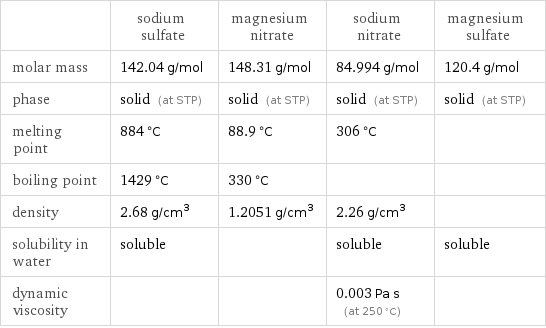
| sodium sulfate | magnesium nitrate | sodium nitrate | magnesium sulfate molar mass | 142.04 g/mol | 148.31 g/mol | 84.994 g/mol | 120.4 g/mol phase | solid (at STP) | solid (at STP) | solid (at STP) | solid (at STP) melting point | 884 °C | 88.9 °C | 306 °C | boiling point | 1429 °C | 330 °C | | density | 2.68 g/cm^3 | 1.2051 g/cm^3 | 2.26 g/cm^3 | solubility in water | soluble | | soluble | soluble dynamic viscosity | | | 0.003 Pa s (at 250 °C) |
Units
